Management Accounting Report: Oakwood Guest House Financial Analysis
VerifiedAdded on 2019/12/18
|17
|5025
|36
Report
AI Summary
This report delves into management accounting practices, specifically focusing on the Oakwood guest house. It begins by outlining different management accounting systems, including cost accounting, inventory management, job costing, and price optimization. The report then presents various types of management accounting reports such as budget reports, account receivable aging, inventory and manufacturing reports, job cost reports, and sales reports. The analysis further explores cost calculation techniques, including traditional cost accounting and transfer pricing. Finally, it discusses the merits and demerits of different budgetary planning techniques and the application of management accounting systems to address financial problems within the guest house. The report emphasizes the importance of these tools for decision-making, financial control, and strategic planning.
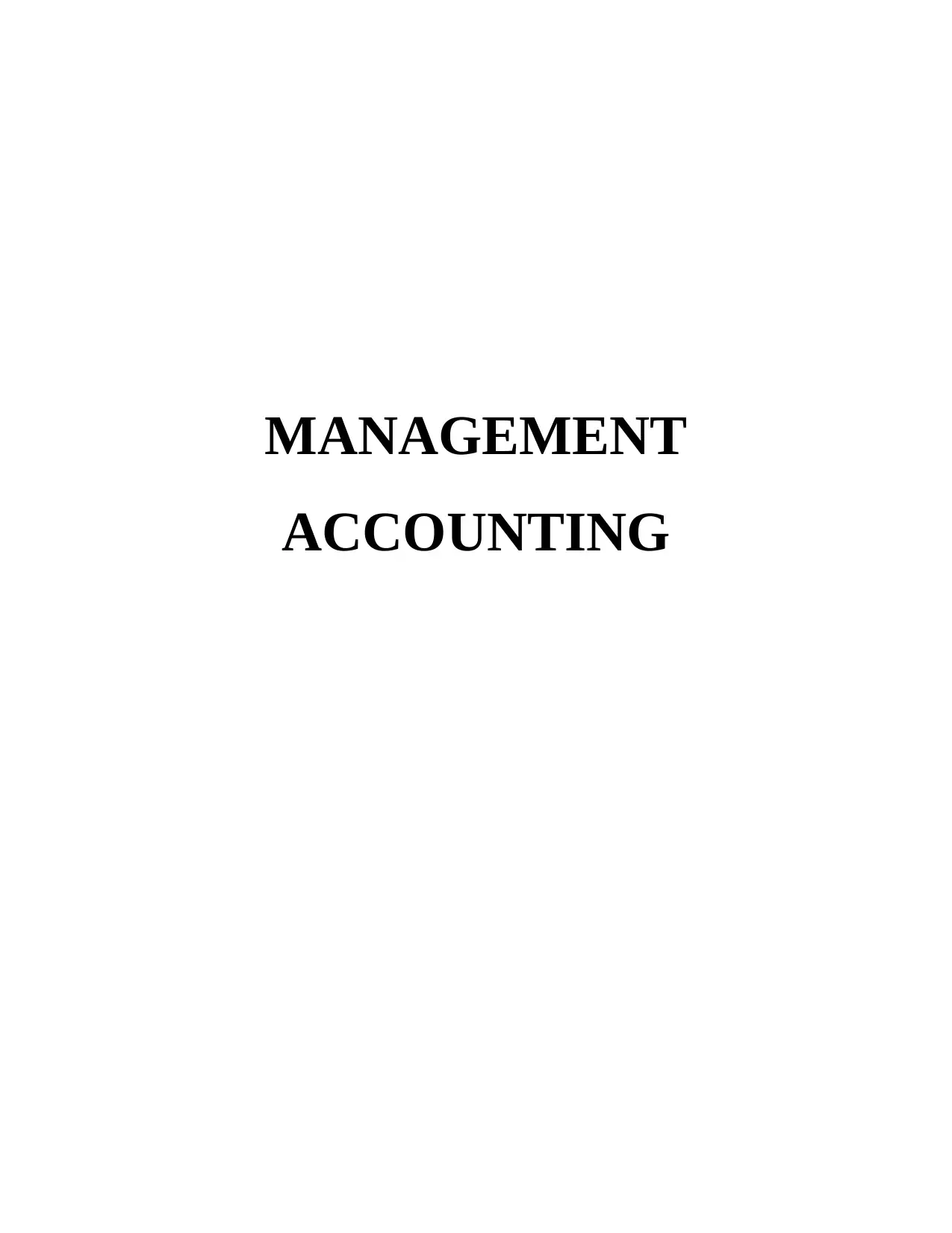
MANAGEMENT
ACCOUNTING
ACCOUNTING
Paraphrase This Document
Need a fresh take? Get an instant paraphrase of this document with our AI Paraphraser
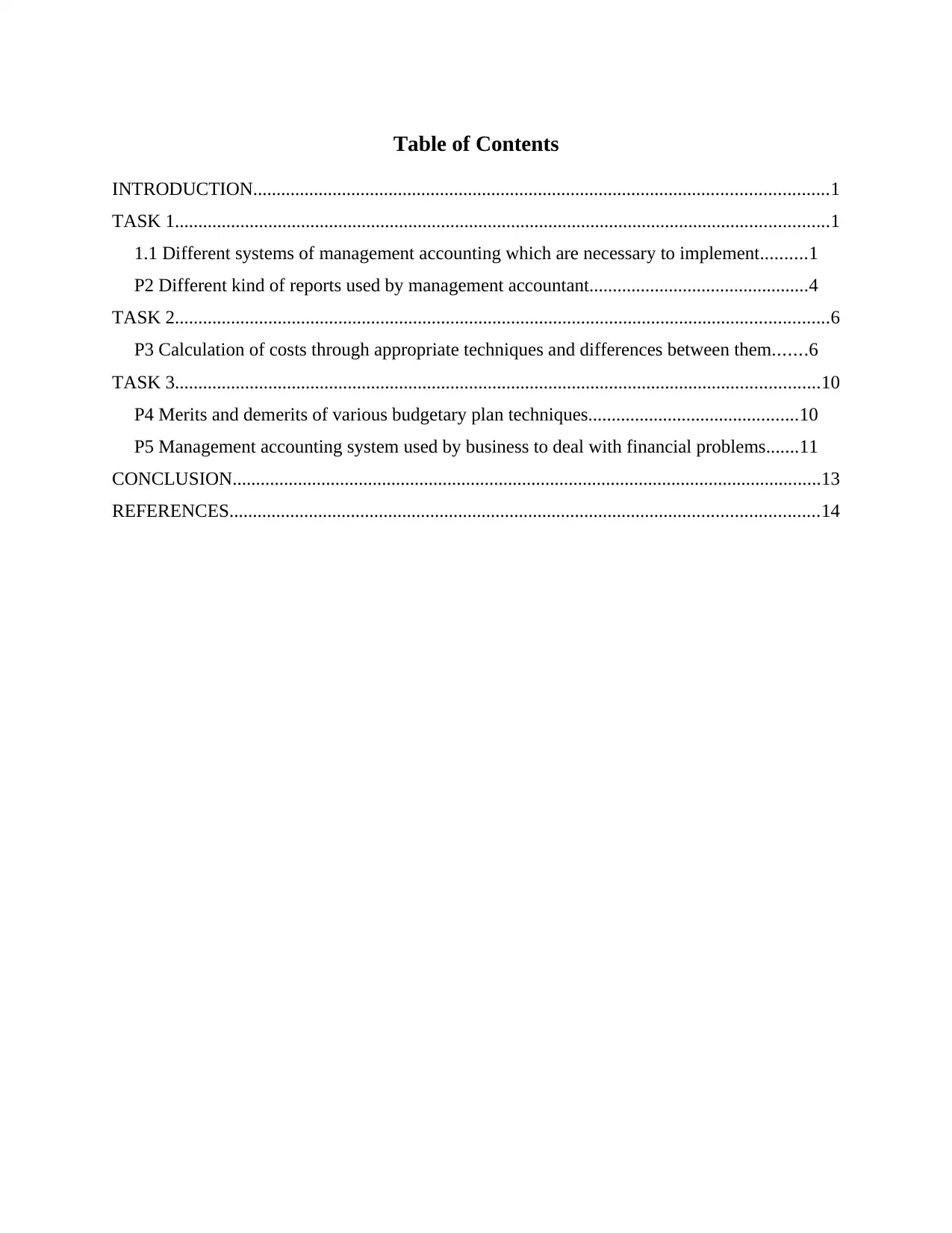
Table of Contents
INTRODUCTION...........................................................................................................................1
TASK 1............................................................................................................................................1
1.1 Different systems of management accounting which are necessary to implement..........1
P2 Different kind of reports used by management accountant...............................................4
TASK 2............................................................................................................................................6
P3 Calculation of costs through appropriate techniques and differences between them.......6
TASK 3..........................................................................................................................................10
P4 Merits and demerits of various budgetary plan techniques.............................................10
P5 Management accounting system used by business to deal with financial problems.......11
CONCLUSION..............................................................................................................................13
REFERENCES..............................................................................................................................14
INTRODUCTION...........................................................................................................................1
TASK 1............................................................................................................................................1
1.1 Different systems of management accounting which are necessary to implement..........1
P2 Different kind of reports used by management accountant...............................................4
TASK 2............................................................................................................................................6
P3 Calculation of costs through appropriate techniques and differences between them.......6
TASK 3..........................................................................................................................................10
P4 Merits and demerits of various budgetary plan techniques.............................................10
P5 Management accounting system used by business to deal with financial problems.......11
CONCLUSION..............................................................................................................................13
REFERENCES..............................................................................................................................14
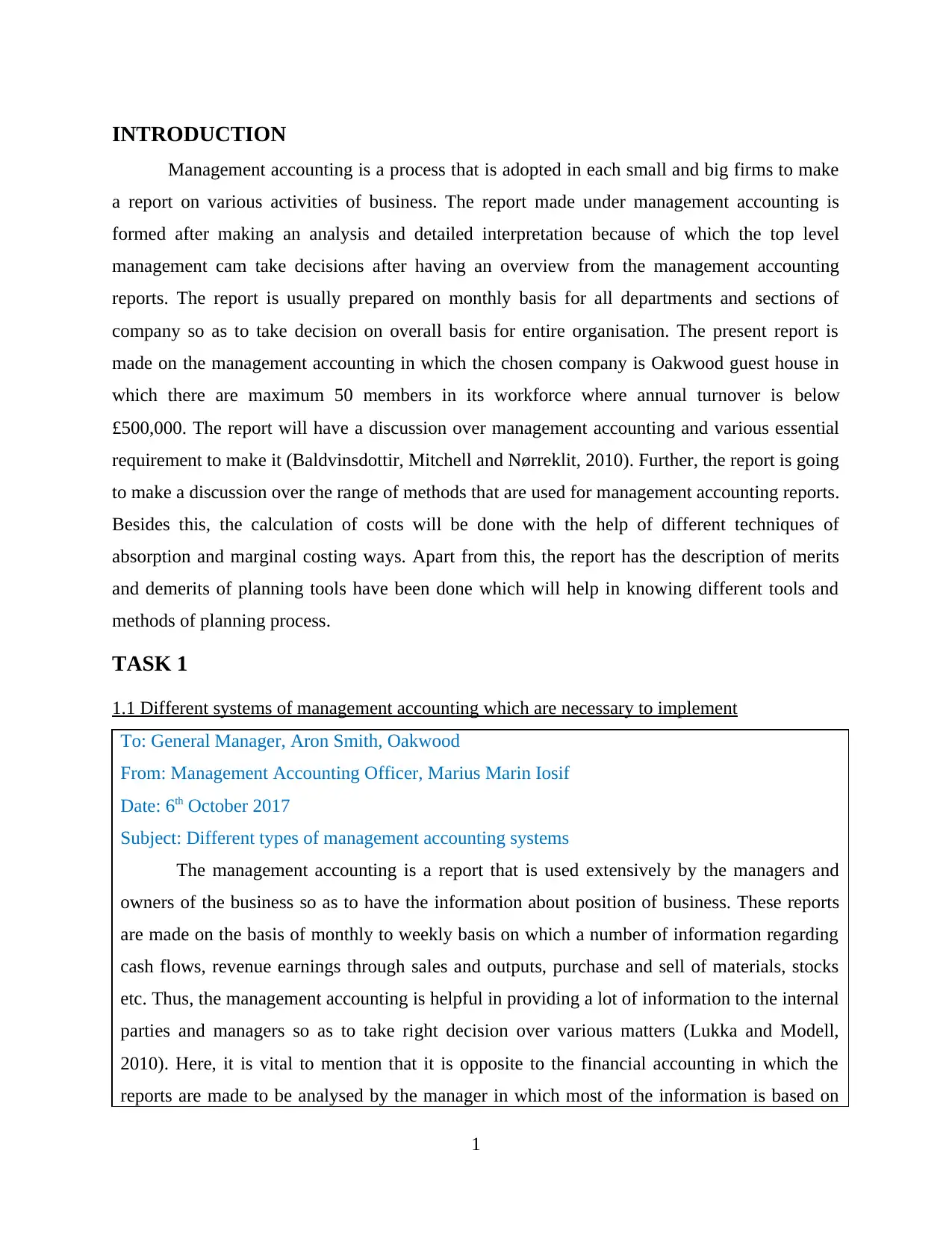
INTRODUCTION
Management accounting is a process that is adopted in each small and big firms to make
a report on various activities of business. The report made under management accounting is
formed after making an analysis and detailed interpretation because of which the top level
management cam take decisions after having an overview from the management accounting
reports. The report is usually prepared on monthly basis for all departments and sections of
company so as to take decision on overall basis for entire organisation. The present report is
made on the management accounting in which the chosen company is Oakwood guest house in
which there are maximum 50 members in its workforce where annual turnover is below
£500,000. The report will have a discussion over management accounting and various essential
requirement to make it (Baldvinsdottir, Mitchell and Nørreklit, 2010). Further, the report is going
to make a discussion over the range of methods that are used for management accounting reports.
Besides this, the calculation of costs will be done with the help of different techniques of
absorption and marginal costing ways. Apart from this, the report has the description of merits
and demerits of planning tools have been done which will help in knowing different tools and
methods of planning process.
TASK 1
1.1 Different systems of management accounting which are necessary to implement
To: General Manager, Aron Smith, Oakwood
From: Management Accounting Officer, Marius Marin Iosif
Date: 6th October 2017
Subject: Different types of management accounting systems
The management accounting is a report that is used extensively by the managers and
owners of the business so as to have the information about position of business. These reports
are made on the basis of monthly to weekly basis on which a number of information regarding
cash flows, revenue earnings through sales and outputs, purchase and sell of materials, stocks
etc. Thus, the management accounting is helpful in providing a lot of information to the internal
parties and managers so as to take right decision over various matters (Lukka and Modell,
2010). Here, it is vital to mention that it is opposite to the financial accounting in which the
reports are made to be analysed by the manager in which most of the information is based on
1
Management accounting is a process that is adopted in each small and big firms to make
a report on various activities of business. The report made under management accounting is
formed after making an analysis and detailed interpretation because of which the top level
management cam take decisions after having an overview from the management accounting
reports. The report is usually prepared on monthly basis for all departments and sections of
company so as to take decision on overall basis for entire organisation. The present report is
made on the management accounting in which the chosen company is Oakwood guest house in
which there are maximum 50 members in its workforce where annual turnover is below
£500,000. The report will have a discussion over management accounting and various essential
requirement to make it (Baldvinsdottir, Mitchell and Nørreklit, 2010). Further, the report is going
to make a discussion over the range of methods that are used for management accounting reports.
Besides this, the calculation of costs will be done with the help of different techniques of
absorption and marginal costing ways. Apart from this, the report has the description of merits
and demerits of planning tools have been done which will help in knowing different tools and
methods of planning process.
TASK 1
1.1 Different systems of management accounting which are necessary to implement
To: General Manager, Aron Smith, Oakwood
From: Management Accounting Officer, Marius Marin Iosif
Date: 6th October 2017
Subject: Different types of management accounting systems
The management accounting is a report that is used extensively by the managers and
owners of the business so as to have the information about position of business. These reports
are made on the basis of monthly to weekly basis on which a number of information regarding
cash flows, revenue earnings through sales and outputs, purchase and sell of materials, stocks
etc. Thus, the management accounting is helpful in providing a lot of information to the internal
parties and managers so as to take right decision over various matters (Lukka and Modell,
2010). Here, it is vital to mention that it is opposite to the financial accounting in which the
reports are made to be analysed by the manager in which most of the information is based on
1
⊘ This is a preview!⊘
Do you want full access?
Subscribe today to unlock all pages.

Trusted by 1+ million students worldwide
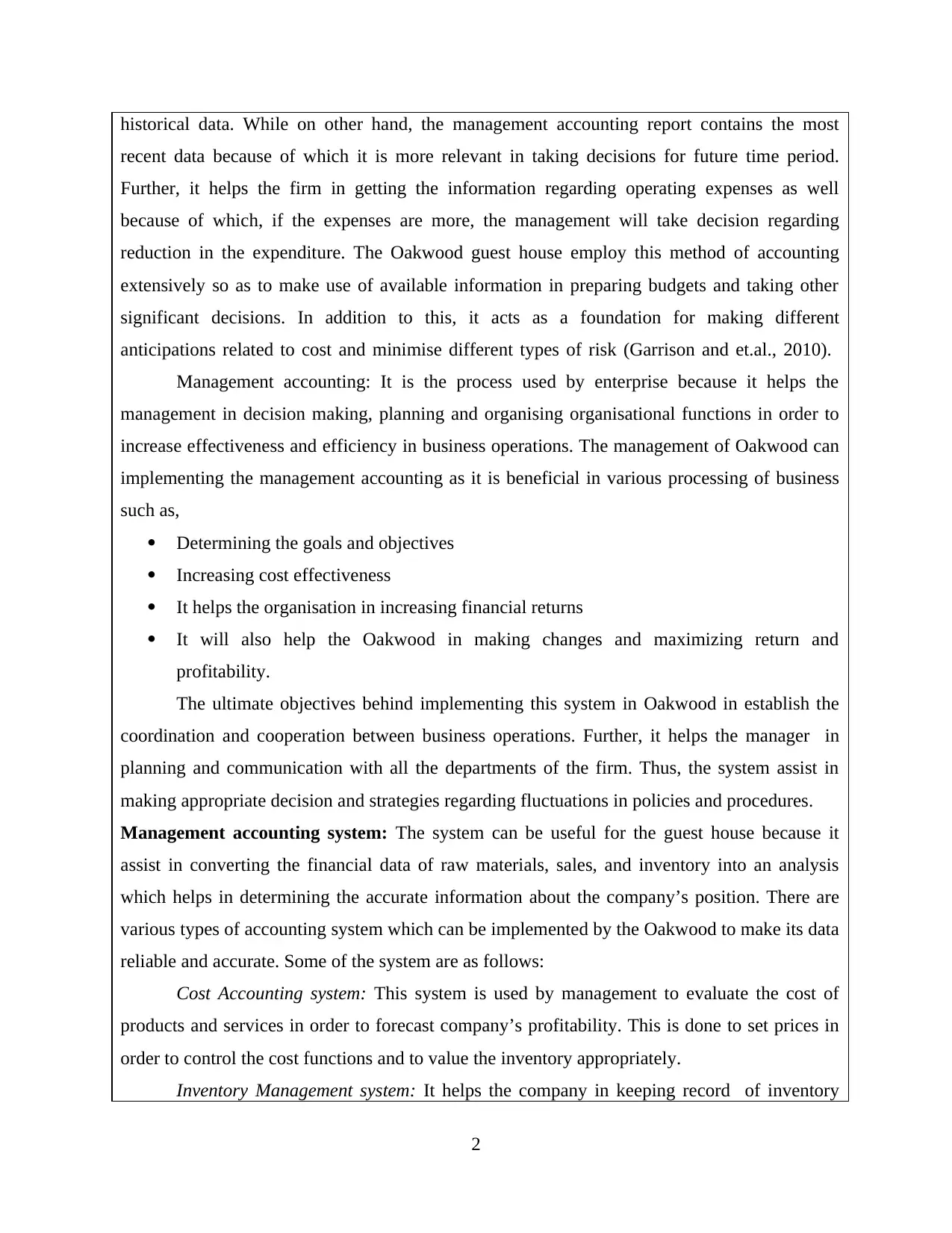
historical data. While on other hand, the management accounting report contains the most
recent data because of which it is more relevant in taking decisions for future time period.
Further, it helps the firm in getting the information regarding operating expenses as well
because of which, if the expenses are more, the management will take decision regarding
reduction in the expenditure. The Oakwood guest house employ this method of accounting
extensively so as to make use of available information in preparing budgets and taking other
significant decisions. In addition to this, it acts as a foundation for making different
anticipations related to cost and minimise different types of risk (Garrison and et.al., 2010).
Management accounting: It is the process used by enterprise because it helps the
management in decision making, planning and organising organisational functions in order to
increase effectiveness and efficiency in business operations. The management of Oakwood can
implementing the management accounting as it is beneficial in various processing of business
such as,
Determining the goals and objectives
Increasing cost effectiveness
It helps the organisation in increasing financial returns
It will also help the Oakwood in making changes and maximizing return and
profitability.
The ultimate objectives behind implementing this system in Oakwood in establish the
coordination and cooperation between business operations. Further, it helps the manager in
planning and communication with all the departments of the firm. Thus, the system assist in
making appropriate decision and strategies regarding fluctuations in policies and procedures.
Management accounting system: The system can be useful for the guest house because it
assist in converting the financial data of raw materials, sales, and inventory into an analysis
which helps in determining the accurate information about the company’s position. There are
various types of accounting system which can be implemented by the Oakwood to make its data
reliable and accurate. Some of the system are as follows:
Cost Accounting system: This system is used by management to evaluate the cost of
products and services in order to forecast company’s profitability. This is done to set prices in
order to control the cost functions and to value the inventory appropriately.
Inventory Management system: It helps the company in keeping record of inventory
2
recent data because of which it is more relevant in taking decisions for future time period.
Further, it helps the firm in getting the information regarding operating expenses as well
because of which, if the expenses are more, the management will take decision regarding
reduction in the expenditure. The Oakwood guest house employ this method of accounting
extensively so as to make use of available information in preparing budgets and taking other
significant decisions. In addition to this, it acts as a foundation for making different
anticipations related to cost and minimise different types of risk (Garrison and et.al., 2010).
Management accounting: It is the process used by enterprise because it helps the
management in decision making, planning and organising organisational functions in order to
increase effectiveness and efficiency in business operations. The management of Oakwood can
implementing the management accounting as it is beneficial in various processing of business
such as,
Determining the goals and objectives
Increasing cost effectiveness
It helps the organisation in increasing financial returns
It will also help the Oakwood in making changes and maximizing return and
profitability.
The ultimate objectives behind implementing this system in Oakwood in establish the
coordination and cooperation between business operations. Further, it helps the manager in
planning and communication with all the departments of the firm. Thus, the system assist in
making appropriate decision and strategies regarding fluctuations in policies and procedures.
Management accounting system: The system can be useful for the guest house because it
assist in converting the financial data of raw materials, sales, and inventory into an analysis
which helps in determining the accurate information about the company’s position. There are
various types of accounting system which can be implemented by the Oakwood to make its data
reliable and accurate. Some of the system are as follows:
Cost Accounting system: This system is used by management to evaluate the cost of
products and services in order to forecast company’s profitability. This is done to set prices in
order to control the cost functions and to value the inventory appropriately.
Inventory Management system: It helps the company in keeping record of inventory
2
Paraphrase This Document
Need a fresh take? Get an instant paraphrase of this document with our AI Paraphraser
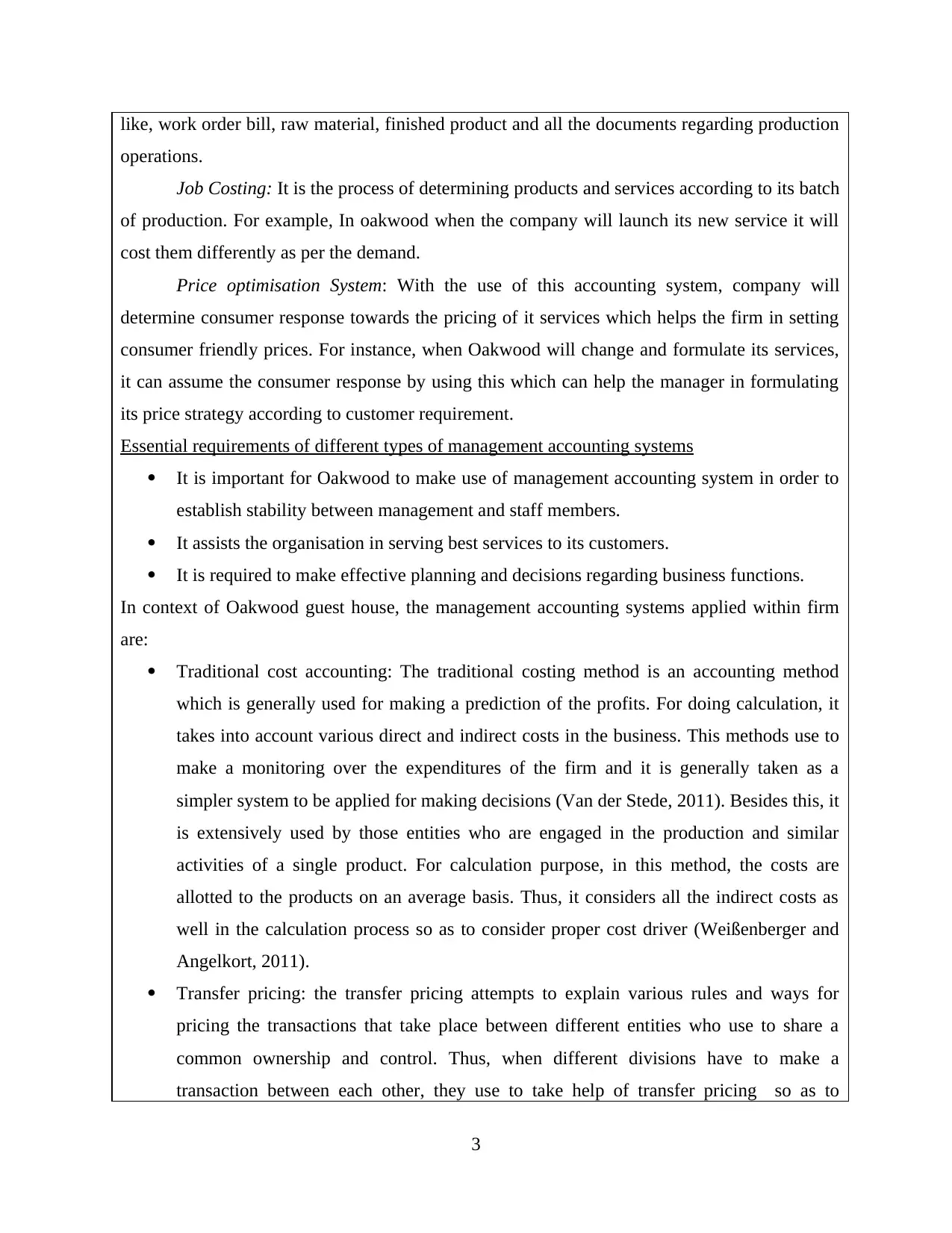
like, work order bill, raw material, finished product and all the documents regarding production
operations.
Job Costing: It is the process of determining products and services according to its batch
of production. For example, In oakwood when the company will launch its new service it will
cost them differently as per the demand.
Price optimisation System: With the use of this accounting system, company will
determine consumer response towards the pricing of it services which helps the firm in setting
consumer friendly prices. For instance, when Oakwood will change and formulate its services,
it can assume the consumer response by using this which can help the manager in formulating
its price strategy according to customer requirement.
Essential requirements of different types of management accounting systems
It is important for Oakwood to make use of management accounting system in order to
establish stability between management and staff members.
It assists the organisation in serving best services to its customers.
It is required to make effective planning and decisions regarding business functions.
In context of Oakwood guest house, the management accounting systems applied within firm
are:
Traditional cost accounting: The traditional costing method is an accounting method
which is generally used for making a prediction of the profits. For doing calculation, it
takes into account various direct and indirect costs in the business. This methods use to
make a monitoring over the expenditures of the firm and it is generally taken as a
simpler system to be applied for making decisions (Van der Stede, 2011). Besides this, it
is extensively used by those entities who are engaged in the production and similar
activities of a single product. For calculation purpose, in this method, the costs are
allotted to the products on an average basis. Thus, it considers all the indirect costs as
well in the calculation process so as to consider proper cost driver (Weißenberger and
Angelkort, 2011).
Transfer pricing: the transfer pricing attempts to explain various rules and ways for
pricing the transactions that take place between different entities who use to share a
common ownership and control. Thus, when different divisions have to make a
transaction between each other, they use to take help of transfer pricing so as to
3
operations.
Job Costing: It is the process of determining products and services according to its batch
of production. For example, In oakwood when the company will launch its new service it will
cost them differently as per the demand.
Price optimisation System: With the use of this accounting system, company will
determine consumer response towards the pricing of it services which helps the firm in setting
consumer friendly prices. For instance, when Oakwood will change and formulate its services,
it can assume the consumer response by using this which can help the manager in formulating
its price strategy according to customer requirement.
Essential requirements of different types of management accounting systems
It is important for Oakwood to make use of management accounting system in order to
establish stability between management and staff members.
It assists the organisation in serving best services to its customers.
It is required to make effective planning and decisions regarding business functions.
In context of Oakwood guest house, the management accounting systems applied within firm
are:
Traditional cost accounting: The traditional costing method is an accounting method
which is generally used for making a prediction of the profits. For doing calculation, it
takes into account various direct and indirect costs in the business. This methods use to
make a monitoring over the expenditures of the firm and it is generally taken as a
simpler system to be applied for making decisions (Van der Stede, 2011). Besides this, it
is extensively used by those entities who are engaged in the production and similar
activities of a single product. For calculation purpose, in this method, the costs are
allotted to the products on an average basis. Thus, it considers all the indirect costs as
well in the calculation process so as to consider proper cost driver (Weißenberger and
Angelkort, 2011).
Transfer pricing: the transfer pricing attempts to explain various rules and ways for
pricing the transactions that take place between different entities who use to share a
common ownership and control. Thus, when different divisions have to make a
transaction between each other, they use to take help of transfer pricing so as to
3
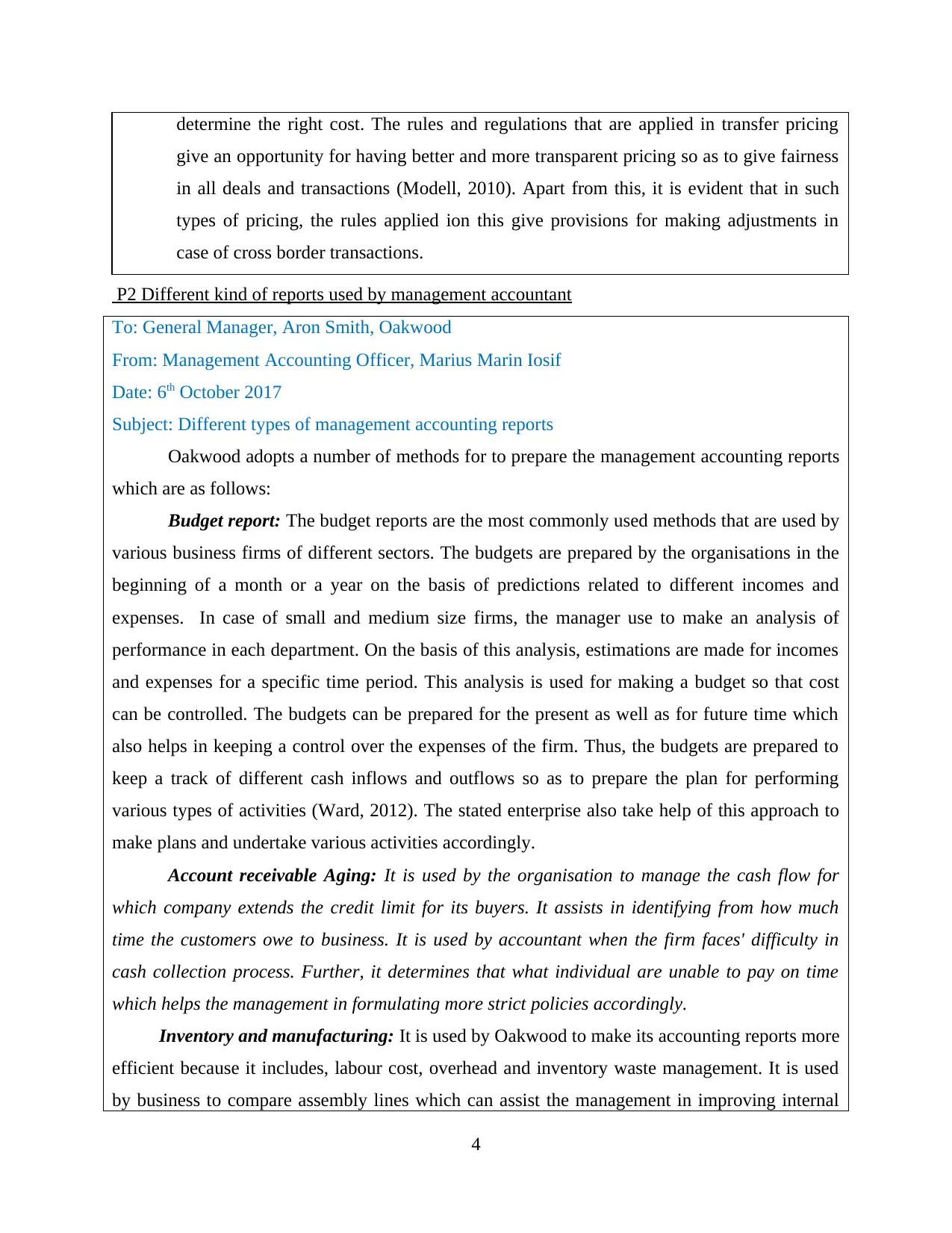
determine the right cost. The rules and regulations that are applied in transfer pricing
give an opportunity for having better and more transparent pricing so as to give fairness
in all deals and transactions (Modell, 2010). Apart from this, it is evident that in such
types of pricing, the rules applied ion this give provisions for making adjustments in
case of cross border transactions.
P2 Different kind of reports used by management accountant
To: General Manager, Aron Smith, Oakwood
From: Management Accounting Officer, Marius Marin Iosif
Date: 6th October 2017
Subject: Different types of management accounting reports
Oakwood adopts a number of methods for to prepare the management accounting reports
which are as follows:
Budget report: The budget reports are the most commonly used methods that are used by
various business firms of different sectors. The budgets are prepared by the organisations in the
beginning of a month or a year on the basis of predictions related to different incomes and
expenses. In case of small and medium size firms, the manager use to make an analysis of
performance in each department. On the basis of this analysis, estimations are made for incomes
and expenses for a specific time period. This analysis is used for making a budget so that cost
can be controlled. The budgets can be prepared for the present as well as for future time which
also helps in keeping a control over the expenses of the firm. Thus, the budgets are prepared to
keep a track of different cash inflows and outflows so as to prepare the plan for performing
various types of activities (Ward, 2012). The stated enterprise also take help of this approach to
make plans and undertake various activities accordingly.
Account receivable Aging: It is used by the organisation to manage the cash flow for
which company extends the credit limit for its buyers. It assists in identifying from how much
time the customers owe to business. It is used by accountant when the firm faces' difficulty in
cash collection process. Further, it determines that what individual are unable to pay on time
which helps the management in formulating more strict policies accordingly.
Inventory and manufacturing: It is used by Oakwood to make its accounting reports more
efficient because it includes, labour cost, overhead and inventory waste management. It is used
by business to compare assembly lines which can assist the management in improving internal
4
give an opportunity for having better and more transparent pricing so as to give fairness
in all deals and transactions (Modell, 2010). Apart from this, it is evident that in such
types of pricing, the rules applied ion this give provisions for making adjustments in
case of cross border transactions.
P2 Different kind of reports used by management accountant
To: General Manager, Aron Smith, Oakwood
From: Management Accounting Officer, Marius Marin Iosif
Date: 6th October 2017
Subject: Different types of management accounting reports
Oakwood adopts a number of methods for to prepare the management accounting reports
which are as follows:
Budget report: The budget reports are the most commonly used methods that are used by
various business firms of different sectors. The budgets are prepared by the organisations in the
beginning of a month or a year on the basis of predictions related to different incomes and
expenses. In case of small and medium size firms, the manager use to make an analysis of
performance in each department. On the basis of this analysis, estimations are made for incomes
and expenses for a specific time period. This analysis is used for making a budget so that cost
can be controlled. The budgets can be prepared for the present as well as for future time which
also helps in keeping a control over the expenses of the firm. Thus, the budgets are prepared to
keep a track of different cash inflows and outflows so as to prepare the plan for performing
various types of activities (Ward, 2012). The stated enterprise also take help of this approach to
make plans and undertake various activities accordingly.
Account receivable Aging: It is used by the organisation to manage the cash flow for
which company extends the credit limit for its buyers. It assists in identifying from how much
time the customers owe to business. It is used by accountant when the firm faces' difficulty in
cash collection process. Further, it determines that what individual are unable to pay on time
which helps the management in formulating more strict policies accordingly.
Inventory and manufacturing: It is used by Oakwood to make its accounting reports more
efficient because it includes, labour cost, overhead and inventory waste management. It is used
by business to compare assembly lines which can assist the management in improving internal
4
⊘ This is a preview!⊘
Do you want full access?
Subscribe today to unlock all pages.

Trusted by 1+ million students worldwide
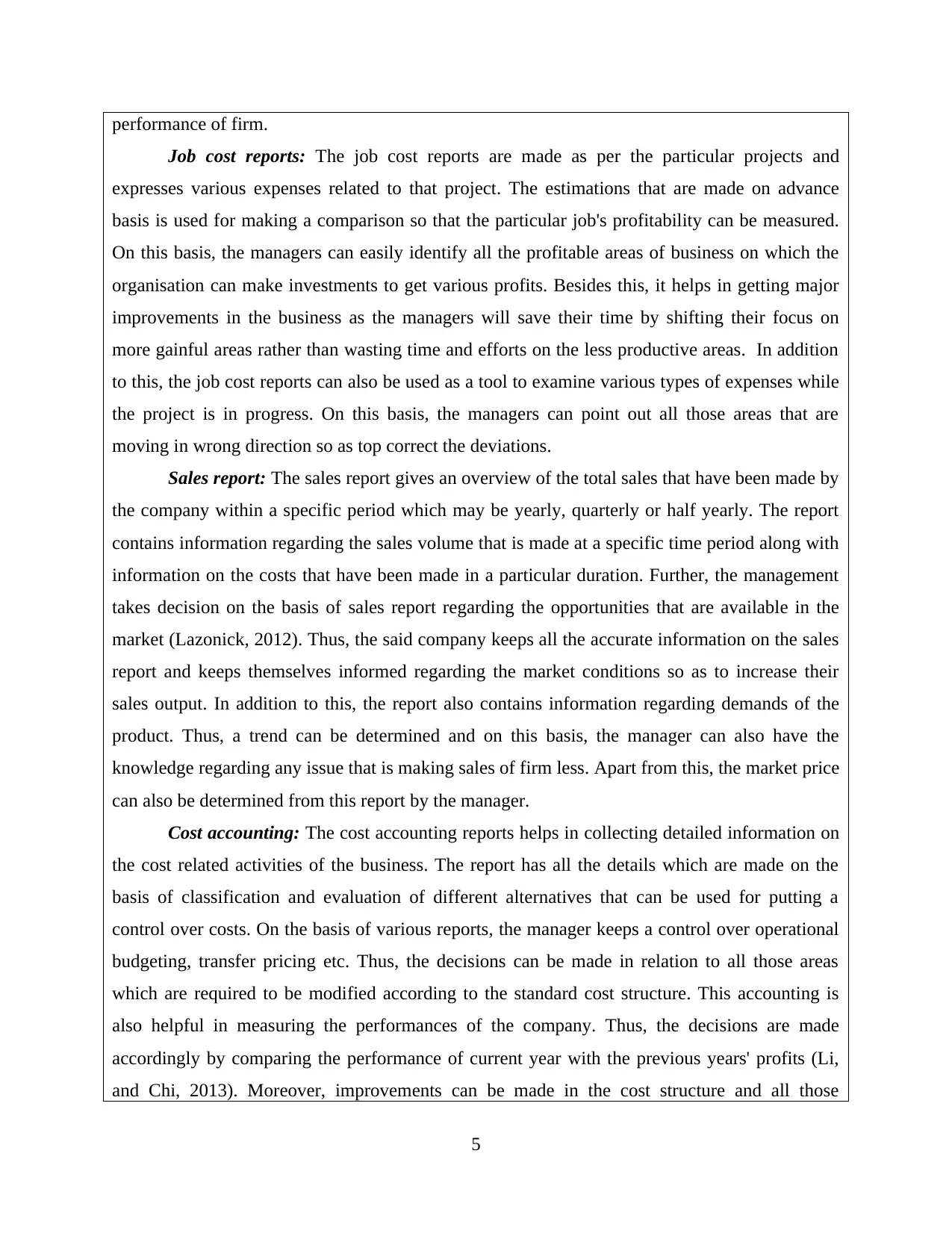
performance of firm.
Job cost reports: The job cost reports are made as per the particular projects and
expresses various expenses related to that project. The estimations that are made on advance
basis is used for making a comparison so that the particular job's profitability can be measured.
On this basis, the managers can easily identify all the profitable areas of business on which the
organisation can make investments to get various profits. Besides this, it helps in getting major
improvements in the business as the managers will save their time by shifting their focus on
more gainful areas rather than wasting time and efforts on the less productive areas. In addition
to this, the job cost reports can also be used as a tool to examine various types of expenses while
the project is in progress. On this basis, the managers can point out all those areas that are
moving in wrong direction so as top correct the deviations.
Sales report: The sales report gives an overview of the total sales that have been made by
the company within a specific period which may be yearly, quarterly or half yearly. The report
contains information regarding the sales volume that is made at a specific time period along with
information on the costs that have been made in a particular duration. Further, the management
takes decision on the basis of sales report regarding the opportunities that are available in the
market (Lazonick, 2012). Thus, the said company keeps all the accurate information on the sales
report and keeps themselves informed regarding the market conditions so as to increase their
sales output. In addition to this, the report also contains information regarding demands of the
product. Thus, a trend can be determined and on this basis, the manager can also have the
knowledge regarding any issue that is making sales of firm less. Apart from this, the market price
can also be determined from this report by the manager.
Cost accounting: The cost accounting reports helps in collecting detailed information on
the cost related activities of the business. The report has all the details which are made on the
basis of classification and evaluation of different alternatives that can be used for putting a
control over costs. On the basis of various reports, the manager keeps a control over operational
budgeting, transfer pricing etc. Thus, the decisions can be made in relation to all those areas
which are required to be modified according to the standard cost structure. This accounting is
also helpful in measuring the performances of the company. Thus, the decisions are made
accordingly by comparing the performance of current year with the previous years' profits (Li,
and Chi, 2013). Moreover, improvements can be made in the cost structure and all those
5
Job cost reports: The job cost reports are made as per the particular projects and
expresses various expenses related to that project. The estimations that are made on advance
basis is used for making a comparison so that the particular job's profitability can be measured.
On this basis, the managers can easily identify all the profitable areas of business on which the
organisation can make investments to get various profits. Besides this, it helps in getting major
improvements in the business as the managers will save their time by shifting their focus on
more gainful areas rather than wasting time and efforts on the less productive areas. In addition
to this, the job cost reports can also be used as a tool to examine various types of expenses while
the project is in progress. On this basis, the managers can point out all those areas that are
moving in wrong direction so as top correct the deviations.
Sales report: The sales report gives an overview of the total sales that have been made by
the company within a specific period which may be yearly, quarterly or half yearly. The report
contains information regarding the sales volume that is made at a specific time period along with
information on the costs that have been made in a particular duration. Further, the management
takes decision on the basis of sales report regarding the opportunities that are available in the
market (Lazonick, 2012). Thus, the said company keeps all the accurate information on the sales
report and keeps themselves informed regarding the market conditions so as to increase their
sales output. In addition to this, the report also contains information regarding demands of the
product. Thus, a trend can be determined and on this basis, the manager can also have the
knowledge regarding any issue that is making sales of firm less. Apart from this, the market price
can also be determined from this report by the manager.
Cost accounting: The cost accounting reports helps in collecting detailed information on
the cost related activities of the business. The report has all the details which are made on the
basis of classification and evaluation of different alternatives that can be used for putting a
control over costs. On the basis of various reports, the manager keeps a control over operational
budgeting, transfer pricing etc. Thus, the decisions can be made in relation to all those areas
which are required to be modified according to the standard cost structure. This accounting is
also helpful in measuring the performances of the company. Thus, the decisions are made
accordingly by comparing the performance of current year with the previous years' profits (Li,
and Chi, 2013). Moreover, improvements can be made in the cost structure and all those
5
Paraphrase This Document
Need a fresh take? Get an instant paraphrase of this document with our AI Paraphraser
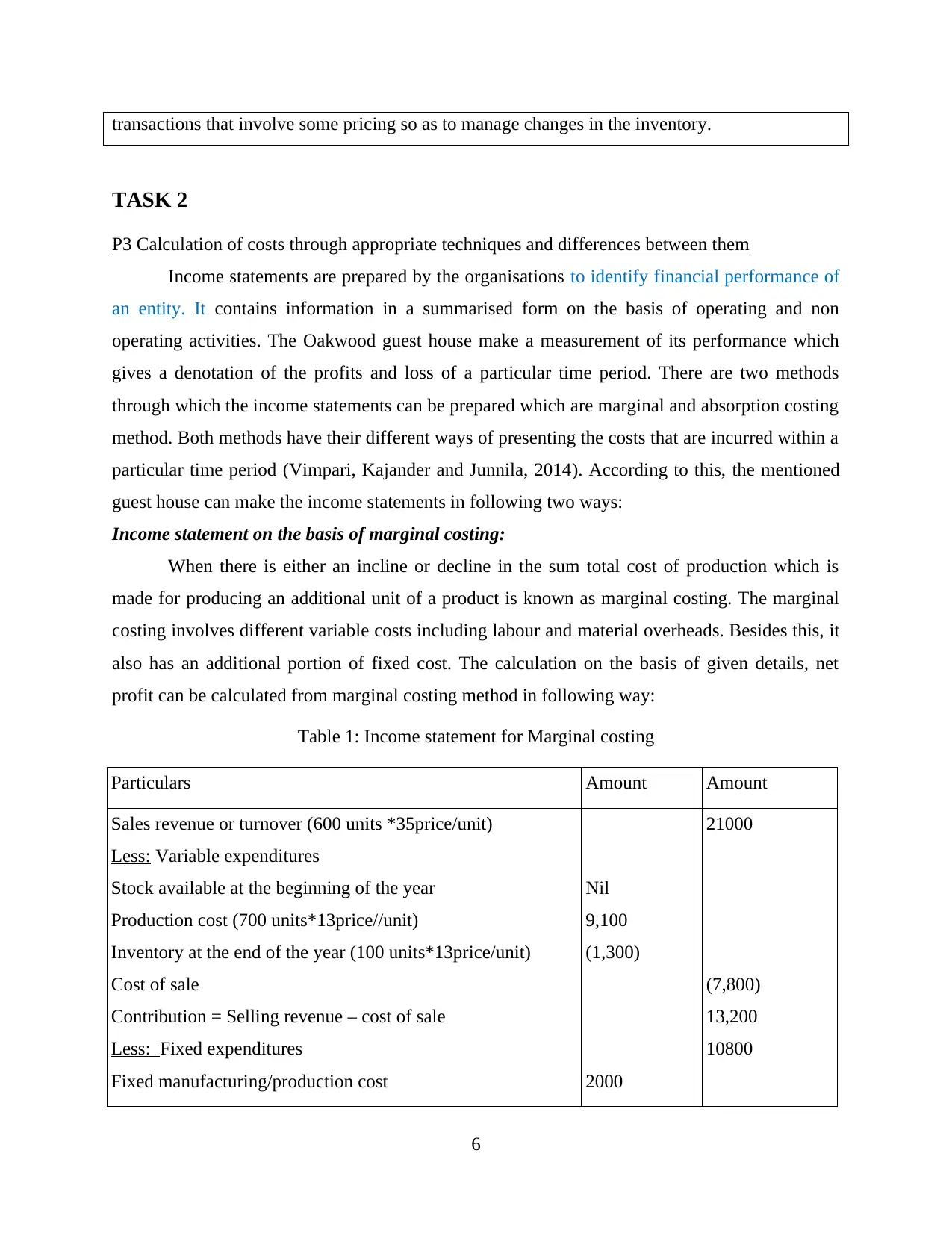
transactions that involve some pricing so as to manage changes in the inventory.
TASK 2
P3 Calculation of costs through appropriate techniques and differences between them
Income statements are prepared by the organisations to identify financial performance of
an entity. It contains information in a summarised form on the basis of operating and non
operating activities. The Oakwood guest house make a measurement of its performance which
gives a denotation of the profits and loss of a particular time period. There are two methods
through which the income statements can be prepared which are marginal and absorption costing
method. Both methods have their different ways of presenting the costs that are incurred within a
particular time period (Vimpari, Kajander and Junnila, 2014). According to this, the mentioned
guest house can make the income statements in following two ways:
Income statement on the basis of marginal costing:
When there is either an incline or decline in the sum total cost of production which is
made for producing an additional unit of a product is known as marginal costing. The marginal
costing involves different variable costs including labour and material overheads. Besides this, it
also has an additional portion of fixed cost. The calculation on the basis of given details, net
profit can be calculated from marginal costing method in following way:
Table 1: Income statement for Marginal costing
Particulars Amount Amount
Sales revenue or turnover (600 units *35price/unit)
Less: Variable expenditures
Stock available at the beginning of the year
Production cost (700 units*13price//unit)
Inventory at the end of the year (100 units*13price/unit)
Cost of sale
Contribution = Selling revenue – cost of sale
Less: Fixed expenditures
Fixed manufacturing/production cost
Nil
9,100
(1,300)
2000
21000
(7,800)
13,200
10800
6
TASK 2
P3 Calculation of costs through appropriate techniques and differences between them
Income statements are prepared by the organisations to identify financial performance of
an entity. It contains information in a summarised form on the basis of operating and non
operating activities. The Oakwood guest house make a measurement of its performance which
gives a denotation of the profits and loss of a particular time period. There are two methods
through which the income statements can be prepared which are marginal and absorption costing
method. Both methods have their different ways of presenting the costs that are incurred within a
particular time period (Vimpari, Kajander and Junnila, 2014). According to this, the mentioned
guest house can make the income statements in following two ways:
Income statement on the basis of marginal costing:
When there is either an incline or decline in the sum total cost of production which is
made for producing an additional unit of a product is known as marginal costing. The marginal
costing involves different variable costs including labour and material overheads. Besides this, it
also has an additional portion of fixed cost. The calculation on the basis of given details, net
profit can be calculated from marginal costing method in following way:
Table 1: Income statement for Marginal costing
Particulars Amount Amount
Sales revenue or turnover (600 units *35price/unit)
Less: Variable expenditures
Stock available at the beginning of the year
Production cost (700 units*13price//unit)
Inventory at the end of the year (100 units*13price/unit)
Cost of sale
Contribution = Selling revenue – cost of sale
Less: Fixed expenditures
Fixed manufacturing/production cost
Nil
9,100
(1,300)
2000
21000
(7,800)
13,200
10800
6
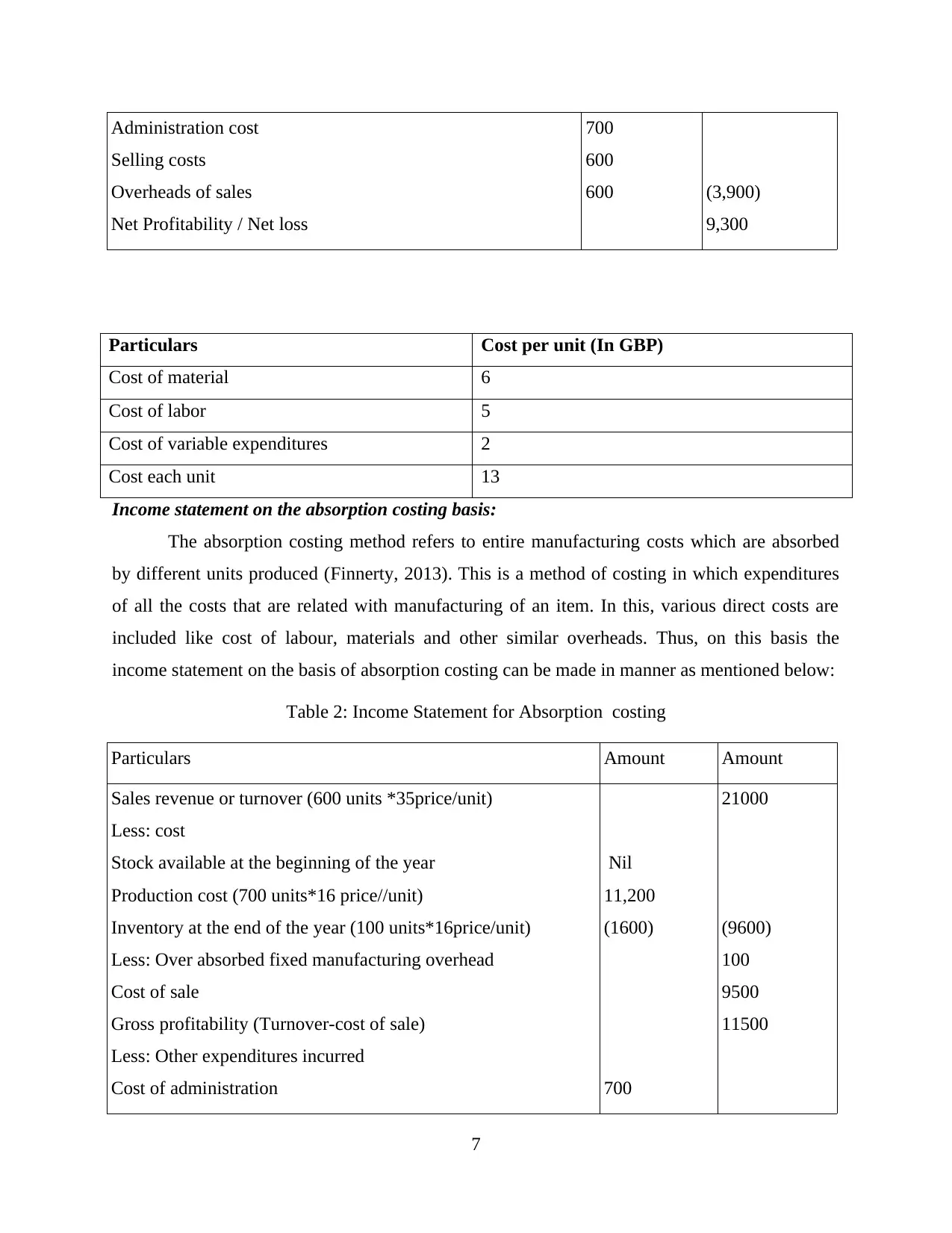
Administration cost
Selling costs
Overheads of sales
Net Profitability / Net loss
700
600
600 (3,900)
9,300
Particulars Cost per unit (In GBP)
Cost of material 6
Cost of labor 5
Cost of variable expenditures 2
Cost each unit 13
Income statement on the absorption costing basis:
The absorption costing method refers to entire manufacturing costs which are absorbed
by different units produced (Finnerty, 2013). This is a method of costing in which expenditures
of all the costs that are related with manufacturing of an item. In this, various direct costs are
included like cost of labour, materials and other similar overheads. Thus, on this basis the
income statement on the basis of absorption costing can be made in manner as mentioned below:
Table 2: Income Statement for Absorption costing
Particulars Amount Amount
Sales revenue or turnover (600 units *35price/unit)
Less: cost
Stock available at the beginning of the year
Production cost (700 units*16 price//unit)
Inventory at the end of the year (100 units*16price/unit)
Less: Over absorbed fixed manufacturing overhead
Cost of sale
Gross profitability (Turnover-cost of sale)
Less: Other expenditures incurred
Cost of administration
Nil
11,200
(1600)
700
21000
(9600)
100
9500
11500
7
Selling costs
Overheads of sales
Net Profitability / Net loss
700
600
600 (3,900)
9,300
Particulars Cost per unit (In GBP)
Cost of material 6
Cost of labor 5
Cost of variable expenditures 2
Cost each unit 13
Income statement on the absorption costing basis:
The absorption costing method refers to entire manufacturing costs which are absorbed
by different units produced (Finnerty, 2013). This is a method of costing in which expenditures
of all the costs that are related with manufacturing of an item. In this, various direct costs are
included like cost of labour, materials and other similar overheads. Thus, on this basis the
income statement on the basis of absorption costing can be made in manner as mentioned below:
Table 2: Income Statement for Absorption costing
Particulars Amount Amount
Sales revenue or turnover (600 units *35price/unit)
Less: cost
Stock available at the beginning of the year
Production cost (700 units*16 price//unit)
Inventory at the end of the year (100 units*16price/unit)
Less: Over absorbed fixed manufacturing overhead
Cost of sale
Gross profitability (Turnover-cost of sale)
Less: Other expenditures incurred
Cost of administration
Nil
11,200
(1600)
700
21000
(9600)
100
9500
11500
7
⊘ This is a preview!⊘
Do you want full access?
Subscribe today to unlock all pages.

Trusted by 1+ million students worldwide
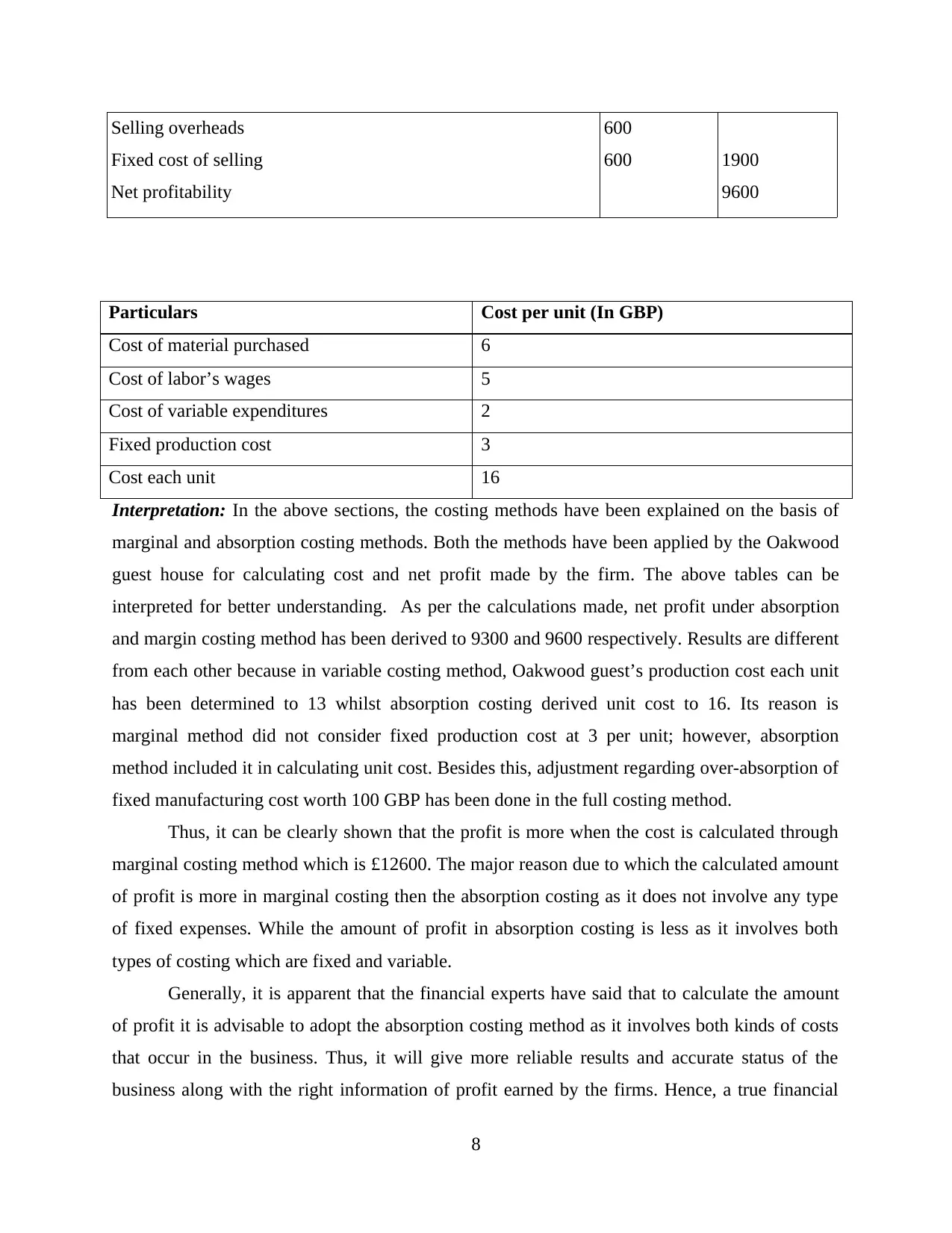
Selling overheads
Fixed cost of selling
Net profitability
600
600 1900
9600
Particulars Cost per unit (In GBP)
Cost of material purchased 6
Cost of labor’s wages 5
Cost of variable expenditures 2
Fixed production cost 3
Cost each unit 16
Interpretation: In the above sections, the costing methods have been explained on the basis of
marginal and absorption costing methods. Both the methods have been applied by the Oakwood
guest house for calculating cost and net profit made by the firm. The above tables can be
interpreted for better understanding. As per the calculations made, net profit under absorption
and margin costing method has been derived to 9300 and 9600 respectively. Results are different
from each other because in variable costing method, Oakwood guest’s production cost each unit
has been determined to 13 whilst absorption costing derived unit cost to 16. Its reason is
marginal method did not consider fixed production cost at 3 per unit; however, absorption
method included it in calculating unit cost. Besides this, adjustment regarding over-absorption of
fixed manufacturing cost worth 100 GBP has been done in the full costing method.
Thus, it can be clearly shown that the profit is more when the cost is calculated through
marginal costing method which is £12600. The major reason due to which the calculated amount
of profit is more in marginal costing then the absorption costing as it does not involve any type
of fixed expenses. While the amount of profit in absorption costing is less as it involves both
types of costing which are fixed and variable.
Generally, it is apparent that the financial experts have said that to calculate the amount
of profit it is advisable to adopt the absorption costing method as it involves both kinds of costs
that occur in the business. Thus, it will give more reliable results and accurate status of the
business along with the right information of profit earned by the firms. Hence, a true financial
8
Fixed cost of selling
Net profitability
600
600 1900
9600
Particulars Cost per unit (In GBP)
Cost of material purchased 6
Cost of labor’s wages 5
Cost of variable expenditures 2
Fixed production cost 3
Cost each unit 16
Interpretation: In the above sections, the costing methods have been explained on the basis of
marginal and absorption costing methods. Both the methods have been applied by the Oakwood
guest house for calculating cost and net profit made by the firm. The above tables can be
interpreted for better understanding. As per the calculations made, net profit under absorption
and margin costing method has been derived to 9300 and 9600 respectively. Results are different
from each other because in variable costing method, Oakwood guest’s production cost each unit
has been determined to 13 whilst absorption costing derived unit cost to 16. Its reason is
marginal method did not consider fixed production cost at 3 per unit; however, absorption
method included it in calculating unit cost. Besides this, adjustment regarding over-absorption of
fixed manufacturing cost worth 100 GBP has been done in the full costing method.
Thus, it can be clearly shown that the profit is more when the cost is calculated through
marginal costing method which is £12600. The major reason due to which the calculated amount
of profit is more in marginal costing then the absorption costing as it does not involve any type
of fixed expenses. While the amount of profit in absorption costing is less as it involves both
types of costing which are fixed and variable.
Generally, it is apparent that the financial experts have said that to calculate the amount
of profit it is advisable to adopt the absorption costing method as it involves both kinds of costs
that occur in the business. Thus, it will give more reliable results and accurate status of the
business along with the right information of profit earned by the firms. Hence, a true financial
8
Paraphrase This Document
Need a fresh take? Get an instant paraphrase of this document with our AI Paraphraser
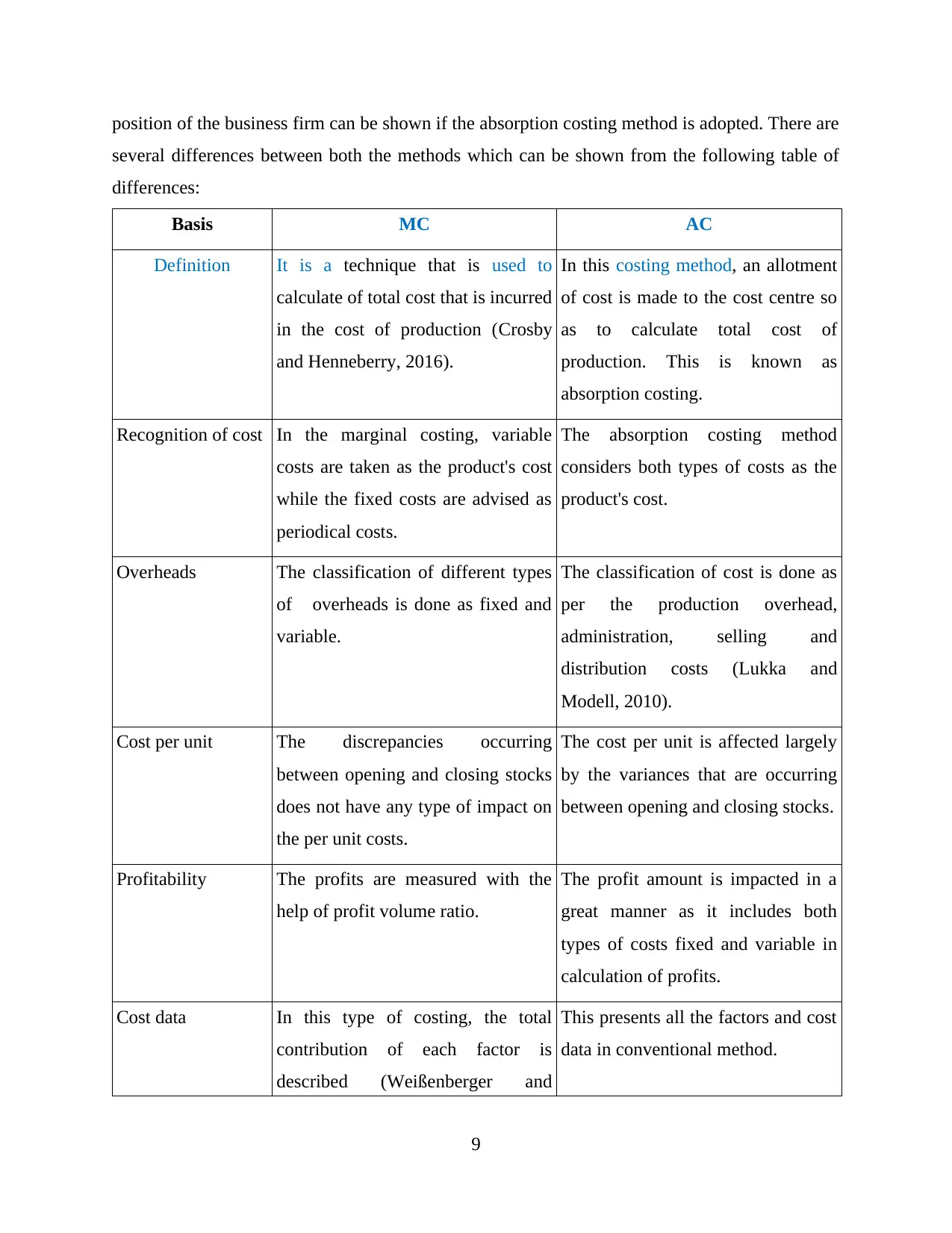
position of the business firm can be shown if the absorption costing method is adopted. There are
several differences between both the methods which can be shown from the following table of
differences:
Basis MC AC
Definition It is a technique that is used to
calculate of total cost that is incurred
in the cost of production (Crosby
and Henneberry, 2016).
In this costing method, an allotment
of cost is made to the cost centre so
as to calculate total cost of
production. This is known as
absorption costing.
Recognition of cost In the marginal costing, variable
costs are taken as the product's cost
while the fixed costs are advised as
periodical costs.
The absorption costing method
considers both types of costs as the
product's cost.
Overheads The classification of different types
of overheads is done as fixed and
variable.
The classification of cost is done as
per the production overhead,
administration, selling and
distribution costs (Lukka and
Modell, 2010).
Cost per unit The discrepancies occurring
between opening and closing stocks
does not have any type of impact on
the per unit costs.
The cost per unit is affected largely
by the variances that are occurring
between opening and closing stocks.
Profitability The profits are measured with the
help of profit volume ratio.
The profit amount is impacted in a
great manner as it includes both
types of costs fixed and variable in
calculation of profits.
Cost data In this type of costing, the total
contribution of each factor is
described (Weißenberger and
This presents all the factors and cost
data in conventional method.
9
several differences between both the methods which can be shown from the following table of
differences:
Basis MC AC
Definition It is a technique that is used to
calculate of total cost that is incurred
in the cost of production (Crosby
and Henneberry, 2016).
In this costing method, an allotment
of cost is made to the cost centre so
as to calculate total cost of
production. This is known as
absorption costing.
Recognition of cost In the marginal costing, variable
costs are taken as the product's cost
while the fixed costs are advised as
periodical costs.
The absorption costing method
considers both types of costs as the
product's cost.
Overheads The classification of different types
of overheads is done as fixed and
variable.
The classification of cost is done as
per the production overhead,
administration, selling and
distribution costs (Lukka and
Modell, 2010).
Cost per unit The discrepancies occurring
between opening and closing stocks
does not have any type of impact on
the per unit costs.
The cost per unit is affected largely
by the variances that are occurring
between opening and closing stocks.
Profitability The profits are measured with the
help of profit volume ratio.
The profit amount is impacted in a
great manner as it includes both
types of costs fixed and variable in
calculation of profits.
Cost data In this type of costing, the total
contribution of each factor is
described (Weißenberger and
This presents all the factors and cost
data in conventional method.
9
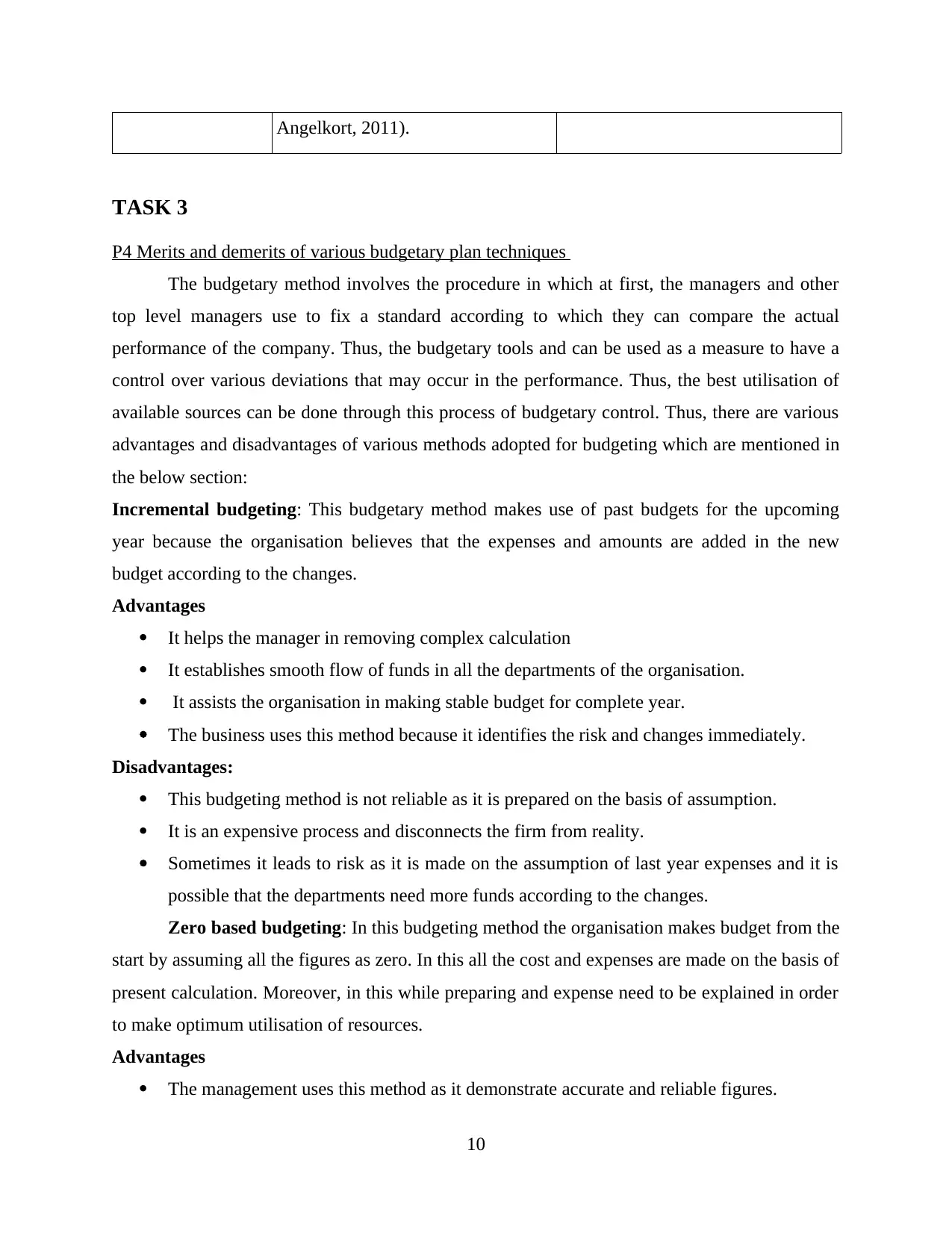
Angelkort, 2011).
TASK 3
P4 Merits and demerits of various budgetary plan techniques
The budgetary method involves the procedure in which at first, the managers and other
top level managers use to fix a standard according to which they can compare the actual
performance of the company. Thus, the budgetary tools and can be used as a measure to have a
control over various deviations that may occur in the performance. Thus, the best utilisation of
available sources can be done through this process of budgetary control. Thus, there are various
advantages and disadvantages of various methods adopted for budgeting which are mentioned in
the below section:
Incremental budgeting: This budgetary method makes use of past budgets for the upcoming
year because the organisation believes that the expenses and amounts are added in the new
budget according to the changes.
Advantages
It helps the manager in removing complex calculation
It establishes smooth flow of funds in all the departments of the organisation.
It assists the organisation in making stable budget for complete year.
The business uses this method because it identifies the risk and changes immediately.
Disadvantages:
This budgeting method is not reliable as it is prepared on the basis of assumption.
It is an expensive process and disconnects the firm from reality.
Sometimes it leads to risk as it is made on the assumption of last year expenses and it is
possible that the departments need more funds according to the changes.
Zero based budgeting: In this budgeting method the organisation makes budget from the
start by assuming all the figures as zero. In this all the cost and expenses are made on the basis of
present calculation. Moreover, in this while preparing and expense need to be explained in order
to make optimum utilisation of resources.
Advantages
The management uses this method as it demonstrate accurate and reliable figures.
10
TASK 3
P4 Merits and demerits of various budgetary plan techniques
The budgetary method involves the procedure in which at first, the managers and other
top level managers use to fix a standard according to which they can compare the actual
performance of the company. Thus, the budgetary tools and can be used as a measure to have a
control over various deviations that may occur in the performance. Thus, the best utilisation of
available sources can be done through this process of budgetary control. Thus, there are various
advantages and disadvantages of various methods adopted for budgeting which are mentioned in
the below section:
Incremental budgeting: This budgetary method makes use of past budgets for the upcoming
year because the organisation believes that the expenses and amounts are added in the new
budget according to the changes.
Advantages
It helps the manager in removing complex calculation
It establishes smooth flow of funds in all the departments of the organisation.
It assists the organisation in making stable budget for complete year.
The business uses this method because it identifies the risk and changes immediately.
Disadvantages:
This budgeting method is not reliable as it is prepared on the basis of assumption.
It is an expensive process and disconnects the firm from reality.
Sometimes it leads to risk as it is made on the assumption of last year expenses and it is
possible that the departments need more funds according to the changes.
Zero based budgeting: In this budgeting method the organisation makes budget from the
start by assuming all the figures as zero. In this all the cost and expenses are made on the basis of
present calculation. Moreover, in this while preparing and expense need to be explained in order
to make optimum utilisation of resources.
Advantages
The management uses this method as it demonstrate accurate and reliable figures.
10
⊘ This is a preview!⊘
Do you want full access?
Subscribe today to unlock all pages.

Trusted by 1+ million students worldwide
1 out of 17
Related Documents
Your All-in-One AI-Powered Toolkit for Academic Success.
+13062052269
info@desklib.com
Available 24*7 on WhatsApp / Email
![[object Object]](/_next/static/media/star-bottom.7253800d.svg)
Unlock your academic potential
Copyright © 2020–2025 A2Z Services. All Rights Reserved. Developed and managed by ZUCOL.





